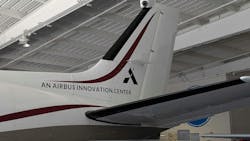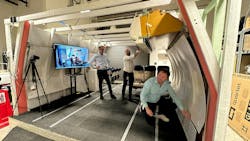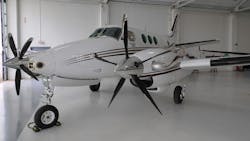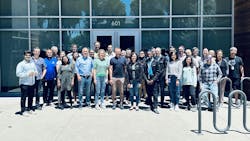Dr. Victoria Coleman Talks AI Innovations for Aerospace at Acubed
Dr. Victoria Coleman, CEO of Acubed, gave Aviation Pros an inside look at the technological transformations and AI projects she’s overseeing.
As the former Director of DARPA and Chief Scientist for the U.S. Air Force, Coleman has led several impactful initiatives, such as passing the CHIPS for America act to aid in domestic semiconductor manufacturing.
Coleman also led Project VENOM, described as, “a $300 million initiative to retrofit six F-16 fighter jets for autonomous flight testing, shaping the future of the Department of Defense’s Collaborative Combat Aircraft program.”
Speaking on her current work, Coleman discussed Acubed’s function as a North America-based research and innovation center for Airbus. She said, “Our mission here is twofold. One is to be like the sentinel, to know what's going on in areas where there are big changes—big technology changes that might affect the company.”
Coleman continued, “But also, because of where we are, we can hire talent that really is not easily available in Europe, so we do special projects here. The first special project that we did 10 years ago was Vahana, which was the first all-electric eVTOL.”
She also explained how the group’s focus has shifted with time, stating, “Now, 10 years on, most of the work that we do is AI. Actually, all the work that we do is based in AI. We're looking at ways of comprehending the significance of AI to the company and how it might change a whole bunch of the things that we do.”
AI Applications at Acubed
On the types of AI projects she oversees at Acubed, Coleman shares, “There’s AI for airplanes and all kinds of products. We do AI for manufacturing…we do AI for services, because now the airplane is connected…and then we're also looking at extraordinary areas around kind of ground connected.”
She continues, “People talk a lot about being connected up in the air, of course. But then when the plane sits on the tarma, it's an information appliance. It's part of the global digital ecosystem at the airport. We want to figure out how to best associate the team to create services to accelerate our customers, and then looking even into more exploratory areas like quantum navigation, for example.”
One project Coleman was especially excited about was Wayfinder, designed to upgrade single-aisle aircraft like the A320.
Coleman explains, “One of them is something that we call VLS: visual landing system. It's adding another layer of safety when it comes to landing. The whole notion is the pilot can see. So, they go for the box. Sometimes you do ILS, if you have the right equipment on the ground to do Instrument Landing. Why not have the airplane have eyes? The airplane can see a lot.”
She continued, “So, what we've been working on for the last four plus years is a visual landing system such that the airplane recognizes the runway, it automatically lines up and basically lands the airplane.”
Coleman also talked about the testing and data that has gone into the VLS project, sharing, “We’ve flown hundreds of flights. And we are able to land an A350 in Toulouse on a Friday morning with sunshine to be able to land at any airport in the United States in all weather conditions.”
In terms of the current state of the VLS project, Coleman said, “They brought the technology to a level of maturity where we now are able to begin handing it off to our engineering colleagues in Europe for full productization certification and so on.”
How AI Can Enhance Automation and Passenger Experience
Coleman spoke on another of Acubed’s areas of exploration, autonomous take-off and landing.
She stated, “The ambition that we have for our next generation single aisle is what we call gate to-gate autonomy…The plane leaves the gate, taxis, takes off, cruises, descends, lands, docks at the gate, all without any kind of human intervention.”
Coleman explained that this goal won’t be realized until far in the future, not due to lack of skill or technical feasibility, but because of the emphasis that Airbus and Acubed put on safety and certification.
Additionally, she stressed that this goal of gate-to-gate autonomy would not completely remove human operators from flight.
Coleman asserted, “When we look at the technology that enables this gate-to-gate autonomy, we can't look at it independent of the community that our plane hosts…We'll never operate it that way. In other words, without pilots, because it's not just about technology. It's about moving a little village that comes together for 10, 12, hours to go around the planet.”
Coleman continued, “It's a community. It's a village. It's a community that happens to be airborne. Within that community there are norms, there are laws, there are ways that we behave, and all these things, this kind of human element of that community in flight is managed. It's mediated by pilots, by flight attendants.”
Building on this idea of supporting a “community in the sky,” Coleman shared innovations that Acubed has planned for enhancing the passenger experience.
Coleman brought up a proposed solution for foot traffic during boarding that stems from passengers scrambling for a place to store their carry-on luggage in the overhead bins.
The hypothetical solution: a program that sends real-time updates to the crew about which overhead bins are taken and which remain empty, allowing flight attendants to guide boarding passengers directly to vacant bins.
Coleman emphasized the plausibility of this tool, noting the technology required to bring it to reality is far less complex than people may think.
She said, “All you need, really, is a cell phone…and you can just see what's going on. If I can recognize if the right engineer is going the right rivet at the right part of the airplane, I can tell if somebody's put up a bag over 21 here.”
Coleman also mentioned generative AI and language learning models (LLMs), sharing, “What it means for us is we can completely, kind of rethink how we train pilots…We're running a project here to build an intelligent pilot assistant to help accelerate training.
She added, “Pilots train for all sorts of flying conditions, including departure-from-nominal conditions…the problem with those is that they're very rare. However, you still have to train just like you know they're about to happen tomorrow. So, with a tool like this, we can really accelerate learning, both for nominal but also departure-from-nominal conditions.”
How AI Can Optimize Aerospace Manufacturing
Coleman shared how artificial intelligence and automation could benefit aerospace manufacturing as well.
She noted, “Manufacturing is still very manual. You have people that, literally, every hour have to stop and do the equivalent of a time card…if you're a government contractor, every week you say, I did this with my time...but how about if we were able just to watch and see who did what to whom, so that people wouldn't have to stop…imagine the productivity gain that we can see because of that.”
“We're looking at ways of using visual means to understand activity in the factory, even inside the airplane, around the airplane, for safety. You don't want to be under the engine. When the engine pulls up, maybe having cameras that say, there's a person under there, don't do that would be a very useful thing to have,” Coleman concluded.
Coleman noted how after 30 years in the industry, she still finds the current acceleration of AI unprecedented.
She said, “The speed at which it is evolving, and the breadth of areas that it's affecting, is something that we've never seen before. So, I think that's going to be potentially disruptive…Hopefully we’ll be in a place to take advantage of it.”





